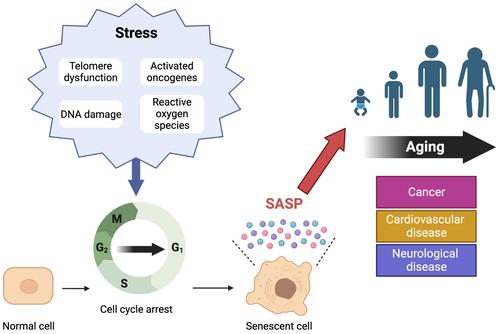当前位置:
X-MOL 学术
›
Cancer Sci.
›
论文详情
Our official English website, www.x-mol.net, welcomes your feedback! (Note: you will need to create a separate account there.)
Senescence and senolysis in cancer: The latest findings
Cancer Science ( IF 5.7 ) Pub Date : 2024-04-19 , DOI: 10.1111/cas.16184 Yoshimi Imawari 1, 2 , Makoto Nakanishi 1
Cancer Science ( IF 5.7 ) Pub Date : 2024-04-19 , DOI: 10.1111/cas.16184 Yoshimi Imawari 1, 2 , Makoto Nakanishi 1
Affiliation

|
Aging is a life phenomenon that occurs in most living organisms and is a major risk factor for many diseases, including cancer. Cellular senescence is a cellular trait induced by various genomic and epigenetic stresses. Senescent cells are characterized by irreversible cell growth arrest and excessive secretion of inflammatory cytokines (senescence-associated secretory phenotypes, SASP). Chronic tissue microinflammation induced by SASP contributes to the pathogenesis of a variety of age-related diseases, including cancer. Senolysis is a promising new strategy to selectively eliminate senescent cells in order to suppress chronic inflammation, suggesting its potential use as an anticancer therapy. This review summarizes recent findings on the molecular basis of senescence in cancer cells and senolysis.
中文翻译:

癌症的衰老和衰老溶解:最新发现
衰老是大多数生物体中发生的一种生命现象,是包括癌症在内的许多疾病的主要危险因素。细胞衰老是由各种基因组和表观遗传应激诱导的细胞特征。衰老细胞的特征是不可逆的细胞生长停滞和炎症细胞因子的过度分泌(衰老相关分泌表型,SASP)。 SASP 引起的慢性组织微炎症有助于多种与年龄相关的疾病(包括癌症)的发病。衰老作用是一种有前途的新策略,可以选择性地消除衰老细胞以抑制慢性炎症,这表明它具有作为抗癌疗法的潜在用途。这篇综述总结了关于癌细胞衰老和衰老作用的分子基础的最新发现。
更新日期:2024-04-19
中文翻译:

癌症的衰老和衰老溶解:最新发现
衰老是大多数生物体中发生的一种生命现象,是包括癌症在内的许多疾病的主要危险因素。细胞衰老是由各种基因组和表观遗传应激诱导的细胞特征。衰老细胞的特征是不可逆的细胞生长停滞和炎症细胞因子的过度分泌(衰老相关分泌表型,SASP)。 SASP 引起的慢性组织微炎症有助于多种与年龄相关的疾病(包括癌症)的发病。衰老作用是一种有前途的新策略,可以选择性地消除衰老细胞以抑制慢性炎症,这表明它具有作为抗癌疗法的潜在用途。这篇综述总结了关于癌细胞衰老和衰老作用的分子基础的最新发现。



























 京公网安备 11010802027423号
京公网安备 11010802027423号